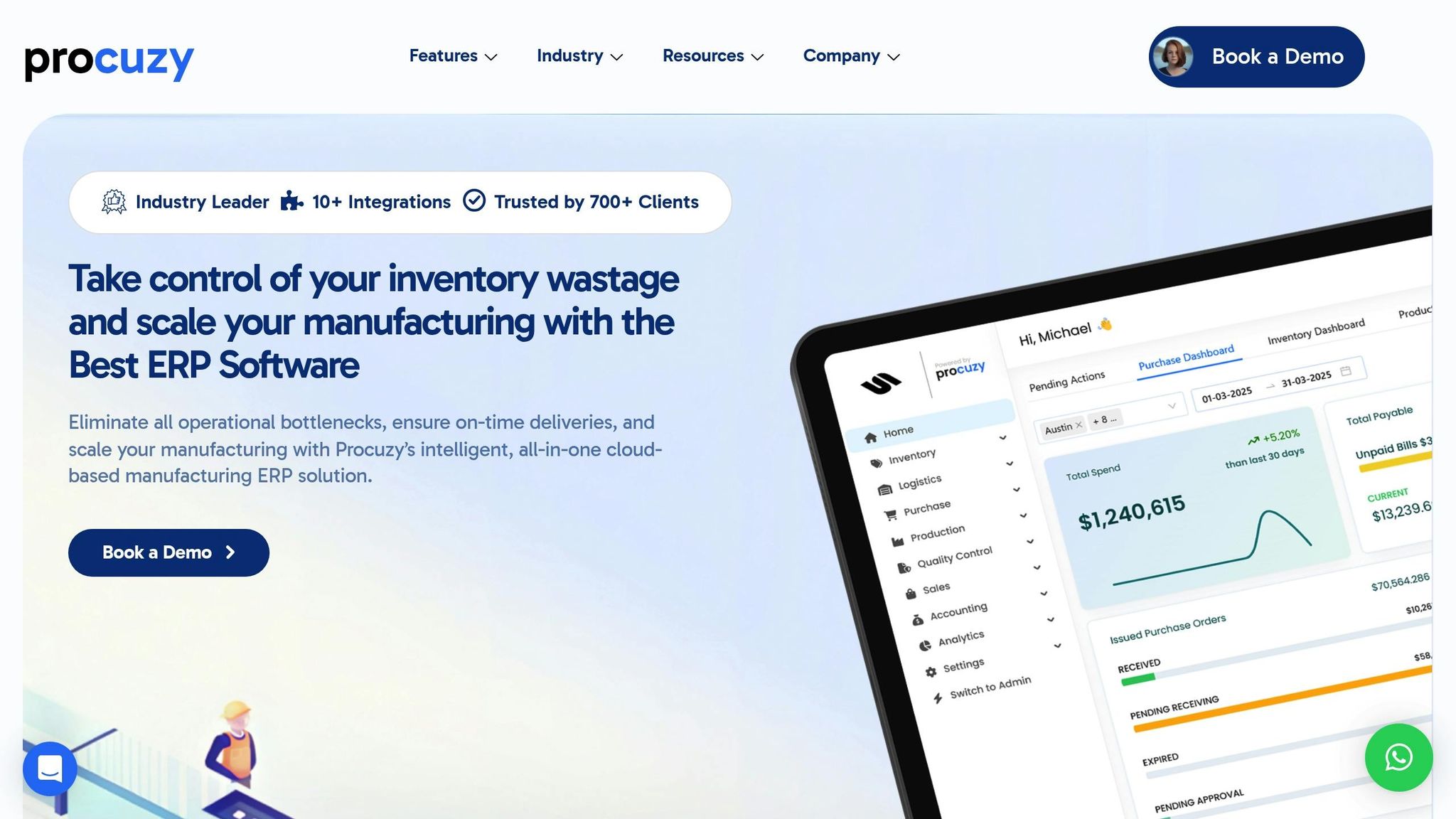Can ERP systems deliver financial results for small manufacturers? The answer is yes, and this article shares three examples of how ERP systems improved efficiency and profitability in small manufacturing businesses.
Key takeaways:
- ERP systems integrate processes like inventory, production, and finance into one platform, reducing errors and saving time.
- ROI metrics include cost savings, faster order fulfillment, higher production efficiency, and better inventory management.
- Case studies of three companies – Omega Industries, Armanino Aerospace, and a materials manufacturer – demonstrate how ERP systems led to measurable improvements, such as a 30% reduction in manual work, an 18% increase in production efficiency, and 38% lower inventory levels.
Quick Overview of Results:
- Omega Industries: Reduced manual tasks by 30%, streamlined finance operations, and avoided major disruptions during a cyberattack.
- Armanino Aerospace: Integrated operations in 8 weeks, improving compliance and decision-making.
- Materials Manufacturer: Achieved 38% lower inventory levels, 13% reduced labor costs, and 8% revenue growth.
ERP systems are practical tools for small manufacturers looking to improve operations and profitability without overwhelming complexity. The right solution, like Procuzy, can simplify processes, deliver fast ROI, and support long-term growth.
Key Metrics for Measuring ERP ROI
Understanding the metrics behind ERP investments is crucial for evaluating how operational changes can directly impact profitability. Below, we break down the core metrics that demonstrate how ERP systems can transform operations into measurable financial gains.
Core Metrics for ROI Evaluation
Cost Savings are one of the clearest indicators of ERP effectiveness. For small manufacturers, this often means cutting down on overtime expenses, reducing the need for last-minute rush orders, and minimizing material waste – each contributing to significant savings.
Inventory Turnover Ratio tracks how effectively a company converts inventory into sales. It’s calculated by dividing the Cost of Goods Sold by the Average Inventory Value. ERP systems often improve this ratio, freeing up valuable cash flow as inventory is turned into revenue more efficiently.
Order Fulfillment Time measures how long it takes to process and ship an order after it’s received. Faster order fulfillment not only boosts customer satisfaction but also encourages repeat business. For small manufacturers, this can be a critical competitive advantage.
Production Efficiency and Revenue Per Employee are two metrics that highlight operational performance. ERP systems enhance production efficiency – often measured through Overall Equipment Effectiveness (OEE) – while also increasing revenue per employee. The latter is calculated by dividing Total Revenue by the Number of Employees, showing how operational improvements translate into higher income per worker.
Cash Flow Improvement reflects how quickly cash moves through the business cycle. With better inventory management and faster invoicing enabled by ERP systems, businesses can shorten their cash conversion cycle, improving liquidity.
Error Reduction Rates show how well an ERP system reduces mistakes in areas like order entry, inventory management, and production planning. Even small reductions in errors can lead to substantial cost savings over time.
How ERP Systems Impact These Metrics
ERP systems are powerful tools that drive improvements across these key metrics by streamlining processes and enhancing decision-making capabilities.
- Data Visibility: Real-time dashboards provide clear insights, eliminating guesswork and enabling smarter resource allocation.
- Automated Workflows: By automating repetitive tasks like data entry and report generation, ERP systems reduce labor costs, cut down on inventory expenses, and minimize waste. This allows employees to focus on higher-value tasks such as improving customer service or refining processes.
- Integrated Planning Tools: ERP systems optimize production schedules by considering real-time demand, material availability, and machine capacity. This reduces overproduction and prevents stockouts.
- Standardized Processes: Consistency across departments lowers error rates and shortens training times for new employees. When everyone follows the same procedures for tasks like order processing or inventory updates, accuracy improves.
- Enhanced Forecasting: Modern ERP platforms offer advanced forecasting tools that help small manufacturers predict demand more accurately. This reduces excess inventory costs while also minimizing lost sales opportunities.
For small manufacturers, the key to success lies in choosing an ERP system that aligns with their specific needs. Overly complex systems can overwhelm smaller operations, so it’s essential to select a solution that balances functionality with simplicity. These targeted improvements highlight how ERP systems can deliver measurable ROI, making them a valuable investment for small-scale manufacturers.
Case Study 1: Omega Industries

Challenges Faced by Omega Industries
Omega Industries, Inc., a prominent supplier of mainline railroad crossings in the U.S., found themselves grappling with major inefficiencies that stifled their growth after four decades in business. A failed five-year ERP implementation left the company with disconnected systems and labor-intensive manual processes that drained time and resources.
Their finance operations were particularly burdensome. Employees spent hours each day on manual data entry, and quarterly tasks like inventory and payroll could take anywhere from four hours to two full days. The lack of system integration meant staff were stuck in repetitive workflows instead of focusing on tasks that could drive the business forward. Real-time performance insights were also out of reach due to these fragmented processes.
Determined to address these issues, Omega Industries decided to implement an integrated cloud ERP solution.
ERP Implementation and Solutions
In 2024, Omega Industries teamed up with Encore Business Solutions to roll out Dynamics 365 Business Central. This time, they adopted a phased approach to avoid repeating the mistakes of their earlier failed attempt. The process began with finance operations, followed by inventory management and manufacturing workflows. This step-by-step strategy directly tackled the time-draining finance processes and disjointed data systems.
The finance phase was completed in just nine months – an impressive turnaround compared to their previous five-year struggle. The cloud-based ERP system brought immediate advantages, such as the "Edit in Excel" feature, which allowed employees to upload data using familiar spreadsheet tools. This integration streamlined processes and eliminated redundant data entry across different systems.
The new ERP automated many manual tasks, freeing up valuable time and enabling seamless collaboration between departments.
"Encore helped us achieve in about nine months what we couldn’t accomplish in five years. That’s the big success story right there." – Maria Leonard, Corporate Controller, Omega Industries
Results and ROI Achieved
The implementation delivered tangible results that boosted Omega Industries’ efficiency and profitability. By cutting down on manual work, the company saved at least 30% of its time, allowing employees to shift their focus to more strategic activities. Tasks like daily finance entries, which once took hours, now take just minutes. Quarterly inventory and payroll processes that previously required up to two days are now completed almost instantly.
The benefits extended beyond day-to-day operations. When a cyberattack caused a three-week outage, the cloud-based ERP system proved to be a lifeline. It ensured that critical functions like billing and vendor payments continued without disruption, safeguarding the company’s operations during a crisis.
"The transition to a cloud-based ERP saved us in a recent cyberattack. The only way we were able to continue to bill customers and pay vendors during the three-week outage was entirely thanks to Business Central!" – Maria Leonard, Corporate Controller, Omega Industries
Case Study 2: Armanino Aerospace

Pre-ERP Challenges
Armanino Aerospace struggled with disconnected systems that made managing their operations a headache. Without real-time data, they had to rely on manual processes for compiling and reconciling information. This siloed approach to handling financials, sales, supply chain, and operations left them without a clear, unified view of their performance, creating delays in decision-making and limiting their ability to adapt quickly.
To tackle these problems, they decided to adopt a unified ERP system.
The ERP Implementation Journey
Armanino Aerospace chose Microsoft Dynamics 365 Business Central and partnered with Armanino LLP to implement the system using their QuickStart methodology. In just eight weeks, they successfully integrated financials, sales, supply chain, and operations into a single, cloud-based platform. This transformation gave them real-time access to critical data and significantly boosted efficiency across every area of their business.
Case Study 3: Materials Manufacturer Using Cloud ERP
This case highlights how a cloud-based ERP system can tackle long-standing operational issues and drive measurable improvements.
Operational Challenges Before ERP
A mid-sized materials manufacturer in Ohio was grappling with inefficiencies that stifled its growth. The company depended on manual methods for inventory tracking across multiple warehouses, relying heavily on spreadsheets and paper records. These outdated practices led to frequent inventory discrepancies, making it difficult to meet customer demand efficiently. On top of that, the absence of real-time data for production scheduling forced managers to base decisions on historical information, creating bottlenecks and reducing overall operational efficiency.
ERP Implementation and Key Features
To overcome these hurdles, the manufacturer implemented a cloud-based ERP system that transformed its operations. The ERP automated financial workflows, such as invoice generation and approvals, significantly reducing manual data entry. Real-time inventory management provided instant visibility across warehouses, while automated reorder points and demand forecasting ensured optimal stock levels. The system also introduced automated quality control processes and batch tracking, improving traceability and compliance. Additionally, integrated CRM tools allowed sales teams to access up-to-date order status and inventory data, enabling quicker and more informed responses to customer inquiries.
ROI Results and Business Impact
The results within the first year were striking. The cloud ERP helped reduce inventory levels by 38%, increased production efficiency by 18%, and lowered labor costs by 13%. Customer satisfaction saw a 22% improvement, and revenue grew by 8% during the same period. These outcomes underscore how modern ERP systems can streamline inventory management, enhance operational decision-making, and directly contribute to business growth.
sbb-itb-a748ddd
Comparison of ERP ROI Outcomes
Using insights from detailed case studies, we can pinpoint the shared factors that contribute to ERP success for small manufacturers. Across industries, ERP systems have consistently delivered measurable benefits, particularly in reducing costs, improving inventory turnover, and boosting production efficiency.
Results Comparison Table
| Company | Pre-ERP Challenges | ERP Solutions Deployed | Primary ROI Results |
|---|---|---|---|
| Omega Industries | Manual processes, inventory inaccuracies, production delays | Automated workflows, real-time tracking, integrated planning | Lower costs, greater efficiency, faster delivery times |
| Armanino Aerospace | Complex compliance requirements, quality control issues, documentation gaps | Quality management modules, automated compliance tracking, digital documentation | Improved compliance accuracy, fewer quality defects, streamlined audits |
| Ohio Materials Manufacturer | Spreadsheet-based inventory, manual scheduling, multi-warehouse inefficiencies | Cloud-based automation, real-time inventory visibility, demand forecasting | Better inventory management, higher production efficiency, revenue growth |
This table underscores the common threads in ERP-driven success. Each company saw marked improvements in cost savings, inventory optimization, and revenue growth by addressing specific operational pain points.
Key Takeaways and Lessons Learned
The results above reveal several key lessons. Tackling operational challenges head-on was a major driver of ROI. Real-time data played a pivotal role in enabling manufacturers to allocate resources more effectively, cut waste, and enhance customer satisfaction. Automation also proved invaluable, reducing labor costs and minimizing errors by eliminating repetitive manual tasks in areas like production, compliance, and inventory management.
Cloud-based ERP systems stood out for their ability to provide real-time access across multiple locations and streamline implementation.
Beyond their initial goals, all three companies saw additional benefits, such as better customer service, improved financial reporting, and enhanced strategic planning. These improvements highlight how ERP systems can deliver value beyond expectations. Notably, manufacturers achieved measurable ROI within a relatively short period, emphasizing the importance of thorough planning and disciplined execution in realizing the full potential of ERP investments.
How Procuzy Drives ROI for Small Manufacturers

Procuzy has earned its reputation by delivering targeted solutions that echo the successes of companies like Omega Industries, Armanino Aerospace, and a leading materials manufacturer. With over 700 clients placing their trust in its platform, Procuzy offers the tools small manufacturers need to translate operational improvements into measurable results. By addressing common challenges with a cloud-based ERP system, Procuzy ensures that businesses achieve real, tangible ROI.
Procuzy Features for ROI Optimization

Procuzy offers real-time inventory visibility, tackling common inventory headaches. This feature directly enhances key metrics like inventory turnover and order fulfillment times. Automated stock alerts and support for multiple locations help businesses avoid costly stockouts or overstocking. Additionally, demand forecasting ensures optimal stock levels without tying up unnecessary capital.
"Procuzy automated our procurement and inventory tracking, reducing errors and improving efficiency." – Mohan, PKR Equipments
The Smart Production Module takes efficiency even further by utilizing multi-level BOMs (Bill of Materials) to monitor production output. This helps optimize inventory, cut costs, and eliminate dead stock. On average, Procuzy users experience up to a 60% reduction in wastage and a 50% improvement in turnaround times.
Integrated planning tools are another standout feature. Procuzy’s Material Requirement Planning (MRP) aligns production schedules with procurement needs, ensuring materials are available precisely when needed. Automated approvals and streamlined purchase order processing prevent delays, improve cash flow, and enhance overall efficiency. With seamless integrations, workflows are unified, boosting productivity across the board.
Tailored Solutions for Small Manufacturers
Procuzy is purpose-built for small U.S. manufacturers, offering a solution that eliminates hefty upfront hardware and IT expenses. This makes the platform easier to implement and provides manufacturers with real-time data access from virtually anywhere.
The platform’s user-friendly, automated interface minimizes the need for IT support, speeding up adoption and delivering enterprise-level functionality at an affordable price. Many businesses report reducing operational costs by 22% as manual tasks are automated and data accuracy improves.
"With Procuzy, we automated our entire process flow and gained a single tool for tracking all operations, significantly improving efficiency and visibility." – Arpit, Shivanika Foods
Procuzy also addresses the unique complexities of small manufacturers. Its multi-stage production tracking covers everything from raw material procurement to finished product delivery. Built-in quality management tools help businesses maintain high standards without requiring a dedicated quality assurance team. Plus, the platform’s scalability ensures it can grow alongside operations, accommodating increased product complexity without the need for major reconfiguration.
Conclusion: Driving ROI with ERP for Small Manufacturers
The examples discussed in this article – Omega Industries, Armanino Aerospace, and a materials manufacturer – show that small manufacturers can see measurable returns by implementing ERP systems. Each company benefited from smoother operations, reduced costs, and improved production efficiency.
Across these cases, ERP systems proved effective in cutting expenses, managing inventory more efficiently, and enhancing production workflows. These financial gains became evident soon after implementation, demonstrating that ERP solutions provide both immediate and long-term value.
One key takeaway is the importance of selecting an ERP system designed to address the specific needs of small manufacturers. With challenges like limited IT resources, strict budgets, and the demand for quick deployment, cloud-based ERP solutions stand out. They offer advanced functionality without the high costs of maintaining physical infrastructure.
These stories underline the value of features like real-time inventory tracking, automated production planning, and integrated procurement. Together, these tools support sustainable growth and profitability for small manufacturers.
Curious about how ERP can transform your business? Check out Procuzy’s cloud-based solutions to streamline your operations and drive profitability.
FAQs
How can ERP systems help small manufacturers boost production efficiency and reduce manual work?
ERP systems empower small manufacturers to enhance production efficiency and cut down on manual work by automating repetitive tasks like inventory tracking, production scheduling, and procurement. By eliminating the need for manual data entry, these systems not only reduce errors but also speed up processes, saving both time and labor costs.
On top of that, ERP software delivers real-time insights into crucial areas such as inventory levels, production progress, and supply chain performance. This level of visibility helps business owners make informed, proactive decisions, streamline workflows, and avoid delays – all without the constant need for hands-on management. By consolidating essential functions into one platform, ERP systems simplify operations and make them faster and more seamless.
What should small manufacturers consider when choosing an ERP system to ensure it delivers strong ROI?
To get the most out of an ERP system and see a solid return on investment, small manufacturers need to start by pinpointing their specific business challenges and setting clear objectives. Choose an ERP solution that aligns with essential manufacturing goals, such as boosting production efficiency, improving inventory accuracy, and cutting costs. Features like flexibility, easy integration, and intuitive interfaces should also be high on the priority list.
A smooth implementation hinges on thorough preparation, active participation from stakeholders, and strong backing from leadership. Providing proper training and focusing on change management can make all the difference, helping employees embrace the system and drive long-term improvements in operations and financial performance.
How do real-time data and automated workflows in ERP systems help small manufacturers make better decisions and grow their business?
Real-time data in ERP systems provides small manufacturers with immediate access to essential details like inventory levels, production updates, and sales performance. This kind of instant visibility helps eliminate delays and reduces the chances of errors, enabling quicker and more precise decision-making.
Automated workflows handle repetitive tasks such as inventory tracking, order processing, and production scheduling. By automating these processes, businesses save time and free up resources, allowing teams to concentrate on more strategic goals. These combined capabilities boost efficiency, cut costs, and open doors for growth and scaling opportunities.
